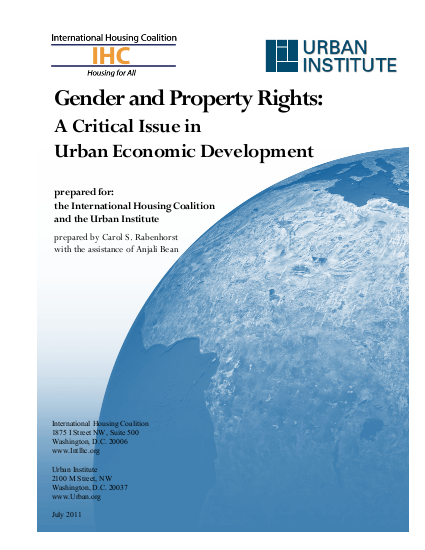
Background. Any objective study of gender and property rights reflects the dismal record of developing countries in providing women with equal rights not only to land but to the basic necessities of life. Women have less access to shelter, income, water, food, education, and healthcare when compared to men, leading to what is often called the “feminization of poverty.” While women are increasingly heads of households, today women and girls make up 70 percent of the estimated 1.2 billion people living in absolute poverty, defined as living on less than $1 a day. It is assumed that most women in poverty operate in the informal sector, particularly those who live in urban areas. In addition, women hold only an estimated 1-2 percent of all titled land in the developing world. The plight of women in poverty seems destined to continue unless there is significant reform and strengthening of laws, policies, and practices relating to ownership and control of property, and among approaches taken by donors and implementers supporting these reforms. Approach. The fundamental premise of this paper is that gender equality in property rights is critical not only as a human rights issue but also as a key driver of overall economic development, particularly in urban settings. While women make up 66 percent of the labor force in urban areas of developing countries, they account for only 10 percent of income. Research clearly shows that when women’s incomes go up, the additional income goes directly to increasing household consumption and therefore into the overall economy, while increases in men’s income more often go into personal consumption. In addition, it is well established that the availability of secure property rights drives economic development through investment in property improvements, increased manufacturing and purchasing on wholesale and retail markets, access to better employment opportunities, and improved health and education. The content of the paper was prepared using desktop research and the author’s own experience. Additional ideas and examples were provided by experts in relevant fields who reviewed and commented on the paper in draft form. Their names are included in the acknowledgments.
Resource collections
- Accountability to affected populations (AAP)
- Topics
- UN Habitat - Urban Response Collection
- Urban Response - Urban Crisis Preparedness and Risk Reduction
- Urban Response Collection - Community Engagement and Social Cohesion
- Urban Response Collection - Economic Recovery
- Urban Response Collection - Environment and Climate Change
- Urban Response Collection - Housing, Land and Property
- Urban Response Collection - Urban Crisis Response, Recovery and Reconstruction
- Urban Response Collection - Urban Resilience
